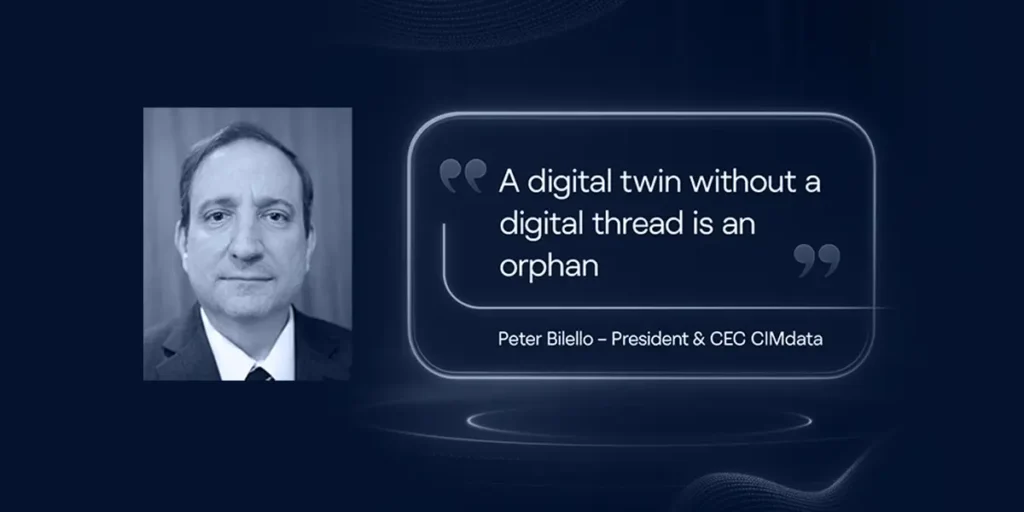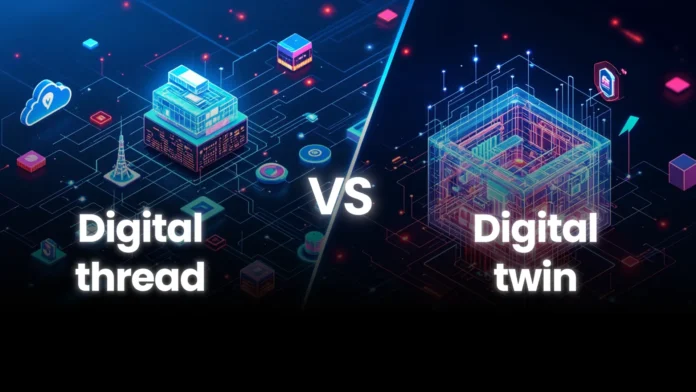Life is all about priorities. You have to choose and embrace what is more important to you. Running a business is not so much different, and for executives in the product lifecycle management (PLM) space, that choice often involves a digital thread and a digital twin.
These are two terms that are collectively part of the industrial metaverse. But there is also quite a bit of noise around their definition and usage. Businesses are confused about where the digital twin and digital thread fit into their digital transformation. As a result, up to 65% of companies are failing to meet their expected ROI on these technologies.
A major reason behind it is that businesses are building standalone digital twins for isolated functions, which is preventing them from capturing the true value that these solutions can offer in product development.
Our approach at Xavor is to follow a comprehensive strategy where digital twins are woven together in a digital thread. This is what makes a true digital twin, which isn’t just a digital model.
In this article, we’ll help you get your priorities straight by proving how a thread-first approach makes better twins and brings more ROI. But first, let’s clear up some technical jargon.
What is a digital twin?
A digital twin is the complete digital replica of a physical product. You can say it is like the doppelganger of a product in the virtual realm. But digital twins aren’t just look-alikes; they mimic the exact behavior and performance of a real-world, physical product.
However, virtual representation doesn’t necessarily mean visual representation. While the majority of digital twin solutions are created using 2D or 3D CAD models, visual representation is not a prerequisite for creating a digital twin.
For example, in an automotive factory, a digital twin of the production line can be built using just databases or spreadsheets to track the availability and assembly of parts.
Essential elements of a digital twin
Whether a digital twin is in the form of a CAD model or a spreadsheet, there are three core elements that are essential to it:
- A physical product or system
- Its virtual representation in software form
- Real-time data exchange between the product and the twin

Tesla uses digital twins to simulate car design and check safety features in case of a crash
The essence of a digital twin is in real-time data exchange. Digital twin companies use Industrial IoT sensors (IIoT) and laser scanners to synchronize the product and its digital twin, ensuring they mirror each other as closely as possible, which makes a digital twin a “living” model of the product.
What is a digital thread?
In product development, there are different types of deliverables beyond design. There is documentation, service manuals, and quality records. All of these tie back to the original design in some way. But these deliverables are not static and change as the product evolves.
If something changes in the design, that change needs to flow down into all the related deliverables. This is what a digital thread is all about. It is a digital representation of a product’s lifecycle that propagates all the changes consistently to ensure everyone across the company stays aligned and works on the latest, correct data. Digital thread technology optimizes traceability and keeps all stakeholders on the same page
Lastly, digital thread implementation requires an authoritative source of truth to connect every deliverable, which are usually PLM software.
What does a thread-first approach mean?
Let’s be clear about what we mean by a thread-first approach. A complete digital thread implementation can take anywhere between 3-6 months to years, depending on the product’s complexity and how much of the lifecycle the company wants to cover.
Therefore, you don’t need to build the entire digital thread upfront. That would be unrealistic. Instead, you should design your digital twin solutions first, but with the digital thread in mind.
In practice, that means that your digital twins:
- Are fed data that comes from authoritative sources i.e., PLM or ERP software
- Are not in siloes but part of a larger ecosystem
- Follow IDs, metadata, and formats that are standardized to connect with other systems
With these foundations in place, creating the digital thread will be easier for your PLM leads.
Our case for building a digital thread
Now, these are the four core reasons why we call for a thread-first approach in product development.
- Enterprise-wide accessibility
- Data alignment
- Faster development cycle
- Supplier and partner integration
1. Enterprise-wide accessibility
Digital twin technology in manufacturing gives engineers a strong visual representation of products. But such standalone digital twin solutions remain confined to only R&D and design teams. If the service or operations teams want to access them, they face challenges because:
- Digital twins are usually managed inside PLM software, which are too complex for non-engineering teams.
- PLM systems are typically “owned” by the engineering department. Therefore, the permissions and data flows are set up around engineering needs.
For a CTO, this means strategic decisions are based on fragmented truths, increasing the risk of slower issue resolution and potential brand damage.
A digital thread, by contrast, is designed to connect data across all lifecycle systems. That means the service team can access the information they need through tools they already use, like ERP or CRM, without having to log into complex engineering platforms.
The fact that service reps can pull the right product configuration or maintenance history directly from CRM means quicker fixes and happier customers. This directly supports top-line growth and retention.
2. Data alignment
Then there is also the issue of siloed data with isolated digital twins. When companies focus on digital twin implementation for a single machine or group of assets, they can’t share data beyond their environment.
What’s the issue with isolated data? Let’s imagine a digital twin that Siemens builds for a gas turbine in its Berlin plant. This twin is excellent for monitoring performance and fine-tuning engines during production.
The problem comes when Siemens’ factory in the US is producing the same type of turbine, but its twin doesn’t share data with the twin in Berlin. Each twin uses different sensors, data formats, and analytics. If a turbine fails in the field at a customer site, the service team is unable determine whether the failure stems from a design flaw, a supplier issue, or something specific to one plant’s processes.
Because the twins are siloed, leadership loses the enterprise-wide view that could show the common root cause and fix the problem globally.
With a digital thread in place, there would’ve been standard identifiers, metadata, and data contracts that cut across Siemens’ plants. Both the Berlin and the US turbine twins would be linked back to a single source of truth for design, bill of materials (BoM), and engineering change orders.
The result? When one twin detects a failure, the same event can be cross-checked against enterprise-wide design and manufacturing data.
3. Faster development cycle
C-level executives like CEOs and CTOs have a hankering for speed. They want faster development cycles to launch new products sooner, capture market share, and gain an edge over competitors.

Peter Bilello has over 30 years of experience in PLM implementation and management
However, speed is hard to achieve. Especially if you work in high-tech industries that make complex products. Digital twin solutions certainly help in this regard by letting engineers compress parts of the development cycle, cutting down on delays and rework.
But when isolated from other enterprise systems, they are mostly good for pilot studies, and not organization-wide data decisions. This can seriously hinder operational impact and business value.
A digital thread integrates design, manufacturing, quality, and service data together. Therefore, with this connected backbone, organizations can achieve true time-to-market acceleration beyond faster pilots.
Additionally, modern PLM platforms like Aras Innovator include a Digital Twin Core, which keeps track of how each product is built, delivered, and maintained in the real world. What makes this powerful is that every digital twin is automatically linked to the same network of data that covers design, manufacturing, service, and operations.
4. Supplier and partner integration
Modern supply chains are a labyrinth of global distributors, suppliers, OEMs, and external partners. To give you an example, China’s first homegrown passenger airliner, Comac C919, uses parts from over a dozen suppliers across the world.
In a situation like this, a digital thread in the aerospace industry turns hundreds of suppliers into an integrated ecosystem. Each supplier operates its own systems with different data formats and identifiers. When companies focus solely on supply chain digital twins without a connected digital thread, supplier data often remains locked in emails, spreadsheets, or custom APIs.
On the other hand, a digital thread provides a shared data backbone that links suppliers and partners into the same ecosystem. It establishes standard identifiers, metadata schemas, and secure access controls, so external contributors can exchange product and process data without version confusion or delays.
For example, when a supplier updates the material specification for an airplane’s wings or sends new fatigue test results, that change automatically flows into the OEM’s digital thread. Engineers at the aircraft manufacturer instantly see how the updated data affects related assemblies or certification compliance with global standards.
This seamless visibility ensures design, testing, and compliance teams are all aligned around the latest validated data.
Conclusion
Digital twin and digital thread are two pillar technologies used in Industry 4.0. But the true value of a digital twin solution is in attaching it to a digital thread. Such twins help teams conduct simulation and modeling using real and validated data.
And the base of building a digital thread is an authoritative source of data. The growth and use of digital twins is only going to increase. However, many organizations think they’ve “gone digital” once they build a few digital twins. What they don’t realize is that digital maturity is about continuity. The most successful businesses are the ones turning isolated models into living, learning ecosystems.
So, it’s time you start analyzing how far along the digital thread your enterprise is.
Think you’re lagging behind? Xavor Corporation has worked with different PLM systems for over 15 years. Our PLM professionals have managed digital twins and digital threads for clients in various industries. We also bring expertise in mature and leading PLM solutions like Oracle Agile, Aras Innovator, and Propel.
Contact us at [email protected] to discuss your digital engineering needs with our experts.


